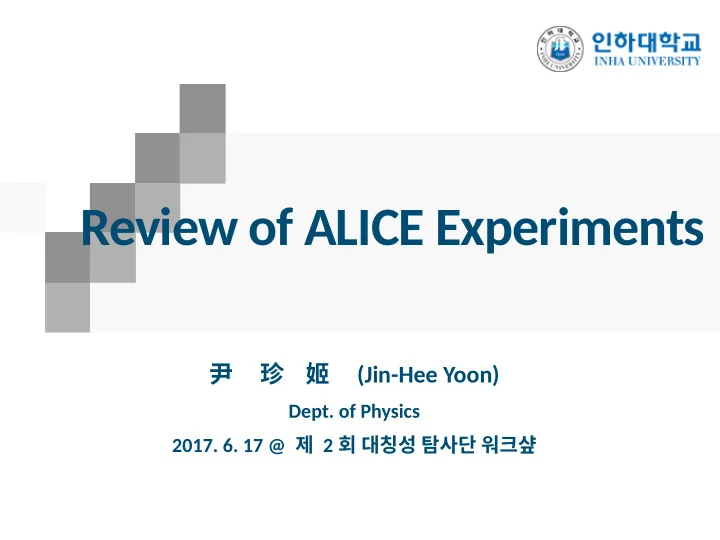

Review of ALICE Experiments 尹 珍 姬 (Jin-Hee Yoon) Dept. of Physics 2017. 6. 17 @ 제 2 회 대칭성 탐사단 워크샾
Outline Introductjon Review of Alice Results ITS upgrade Conclusion
Objects Searching for the initjal stage of Universe From QCD calculatjon, Confjning at normal temperature At high momentum transfer α S becomes weak asymptotjc freedom Quark-Gluon Plasma(QGP)
Lattjce QCD Calculatjon 15 MeV GeV/fm 3
Phase Diagram RHIC, LHC Early universe quark-gluon plasma (QGP) T c hadron gas Temperature Colour super nuclei nucleon gas conductor neutron stars net baryon density ρ 0
How to produce? Theoretjcally Experimentally Heavy Ion Collision
Evolutjons
QGP in the Universe
Observables? High energy process Low energy process Energy loss by quarks, gluons Radiatjon of hadrons and photons and other partjcles (multjplicity, pT spectra, PDF..) Quarkonia and heavy fmavour Azimuthal asymmetry, expansion
Variables Center of Mass Energy Rapidity Pseudo Rapidity At high energy,
A Large Ion Collider Experiment Detector : 16X26 m 10000 tons Collaboratjons : 1500 members, 154 instjtute, 37 countries
ALICE COLLABORATION
Partjcipatjng Instjtutes Participants (39) - 6 Univs. + 1 Insti- tute - Prof : 10 - PhD : 5 - Graduates : 24 Korea-CERN Symposium
Collisions
2015 Pb-Pb Event Display p P b @ 5 T e V
Centrality “Central” “Peripheral” Small impact parameter Large impact parameter Large system volume Small system volume Large partjcle multjplicity Small partjcle multjplicity Map these measurements into IP using Models!
Charged partjcle multjplicity
Sofu Probes – Direct photons Inclusive – Decay = Direct Prompt Hard scatuering High pT Informatjon on PDF, QCD… Thermal Thermal productjon Low/medium pT Informatjon on early thermal state(QGP?)
Radial Flow Thermal + Collectjve expansion velocity MeV
PT spectra of charged partjcles Get fmatuen for more central Stronger efgect for heavier partjcles Heavier partjcles have larger momentum with same velocity
Elliptjc Flow SCIENCE Vol: 298 2179 (2002) 7 Li Anisotropy in momentum Spatjal anisotropy space
Elliptjc Flow v 2 @LHC is 30% larger th an @RHIC. Transfer of the anisotrop y from in space to in mo mentum space viscosi ty info. =0.2 (perfect fmuid)
Strangeness Enhancement In elementary pp collisions, Strangeness products are suppressed relatjve to the productjon of light fmavors For a large system, strangeness is enhanced. How to confjrm?
Nuclear Modifjcatjon Factor : enhancement : suppression
Hard Probes – Jet Quenching
QUARKONIA : pair of c & antj-c Inside the QGP, quarks are color-screened suppression Debye length depends on Temp. thermometer Less suppression than RHIC due to recombinatjon ALICE µµ Phenix µµ
QUARKONIA Suppression is independent of centrality. Need to measure total charm productjon around pT~0 GeV.
Small systems as reference? Nuclear initjal state Nuclear initjal state Hadronic initjal Cold matuer in the fjnal Hot matuer in the fjnal state & fjnal state No phase transitjon in pp or pA collisions is expected. But striking similarity across difgerent systems !
Strangeness
The p T spectra become harder as the multiplicity increases.
• No baryon number dependency. • No mass dependency. • No MC models cannot reproduce this result.
ITS Upgrade Improve IP resolutjon by 3~5 tjmes Closer to IP : 39 mm 23 mm Reduce the material budget : 1.14% 0.3 % Spatjal resolutjon : 12mmX100mm 5mmX5mm Improve tracking effjciency and pT resolutjon at low pT
Conclusion Heavy-ion collisions during RUN1 and RUN2 periods. Energy density ~ 15 GeV/fm 3 >> T=300 MeV Elliptjc fmow from hydro-dynamics QGP as a perfect fmuid suppression smaller than at RHIC dissociatjon + recombinatjon Similaritjes among difgerent systems (pp,p-Pb, Pb-Pb) Collectjvity in small systems? Strangeness enhancement from low to high multjplicity pp collisions Need high precision measurements of the productjon of heavy quarks, quarkonia, jet and di-leptons over a large momentum ra nge. Looking forward to Upgrades
Recommend
More recommend